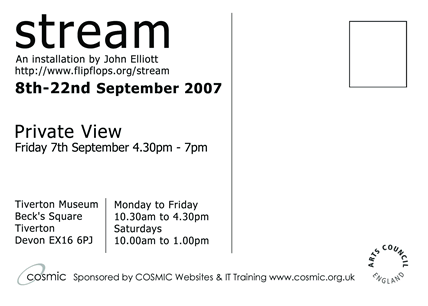I know it’s stupid but whenever I’m on a new machine and need to set up Dreamweaver, I can never remember how to turn off the wordwrap for code view (and spend a lot of time and frustration finding out how to).
View > Code View Options > Word Wrap
I know it’s stupid but whenever I’m on a new machine and need to set up Dreamweaver, I can never remember how to turn off the wordwrap for code view (and spend a lot of time and frustration finding out how to).
View > Code View Options > Word Wrap
It was bugging me what on earth was wrong – becuase not everything was slow so I knew it wasn’t the server… I suppose the amazing thing is it was as fast as it was. Still all fixed now.


Sculptor John Elliott holds his first solo exhibition – a site specific installation at Tiverton Museum, Devon from the 8th – 22nd September 2007.
Elliott, who is funded by the Arts Council England’s Grants for the arts programme is transforming the Waggon Gallery at the museum with a cloud of several hundred brightly coloured butterflies that flow over and around the exhibits usually on display. The exhibition is one of the events taking place as part of the Devon Art Works 2007 event and aims to bring a large scale piece of contemporary art to a wider audience.
(gallery of images of the sculpture under construction)
Some things, such as lakes, seem to have come into being inevitably. Other things, such as the Eiffel Tower, seem to have had to be brought into being with great effort. One of the magical elements of John Elliott’s work is the way in which his sculptural creations look like they should have always existed.
This seems to be so in the large scale outdoor constructions like ‘Rio Hondo Line’ built in the Amazon Jungle and ‘Keri Keri Wave’ (New Zealand). The quality of fitting so well that they should have always been there comes from both the scale of the works being relevant to their environment, and from the materials being of the immediate environment. A uniting sense is made of these two qualities by the fact that the forms of the pieces are themselves organic in their nature. With regard to the practical business of categorisation, this piece could be said to be at the same time ‘sculpture’ and ‘land art’.
By contrast, John’s work with order systems and the alphabet (e.g. 26 things, Alphabet) might be talked about as a primarily ‘conceptual’ piece. As could the text piece ‘Just Imagine’, which one could well think of as resonating with the tradition of Sufi storytelling. It would be misleading however, to contrast these two pieces to such an extent as to give the impression that John works simultaneously in two fields. As an expert violinist can increase and decrease at will the range of pitch variation in his/her vibrato, John has a seemingly endlessly adept skill at varying the tension of plurality between what you see and the feeling that either this has always been so, or this has been made.
Two highly accessible examples of this are ‘Duckadills’ and ‘Cloud’. ‘Duckadills’ has been located both in an exhibition context and the context of a wedding. The ‘Duckadills’ are stems, appearing to grow amidst other plants, with small yellow rubber ducks on top. While it is clear that they have been made, it is immensely enjoyable to imagine that they might grow like that and so one allows oneself to go with the idea.
‘Cloud’ is not so much based on fun but is deeply beautiful in origin. Stems support a cloud of butterflies which are made of postcards sent from around the world for this project. In being set on fragile stems, chiming with the fragility of real butterflies, they appear to quiver and move slightly as the viewer moves around them.
As vibrato gives us a sense of a range of pitch without too bluntly expounding a specific note, John’s work touches the viewer on a range of different levels, giving both a sense of fun and accessibility but also a contemplative and thought provoking calm, without being tied to one specific message or bias. Thought provoking without prejudice, and a greatachievement therefore.